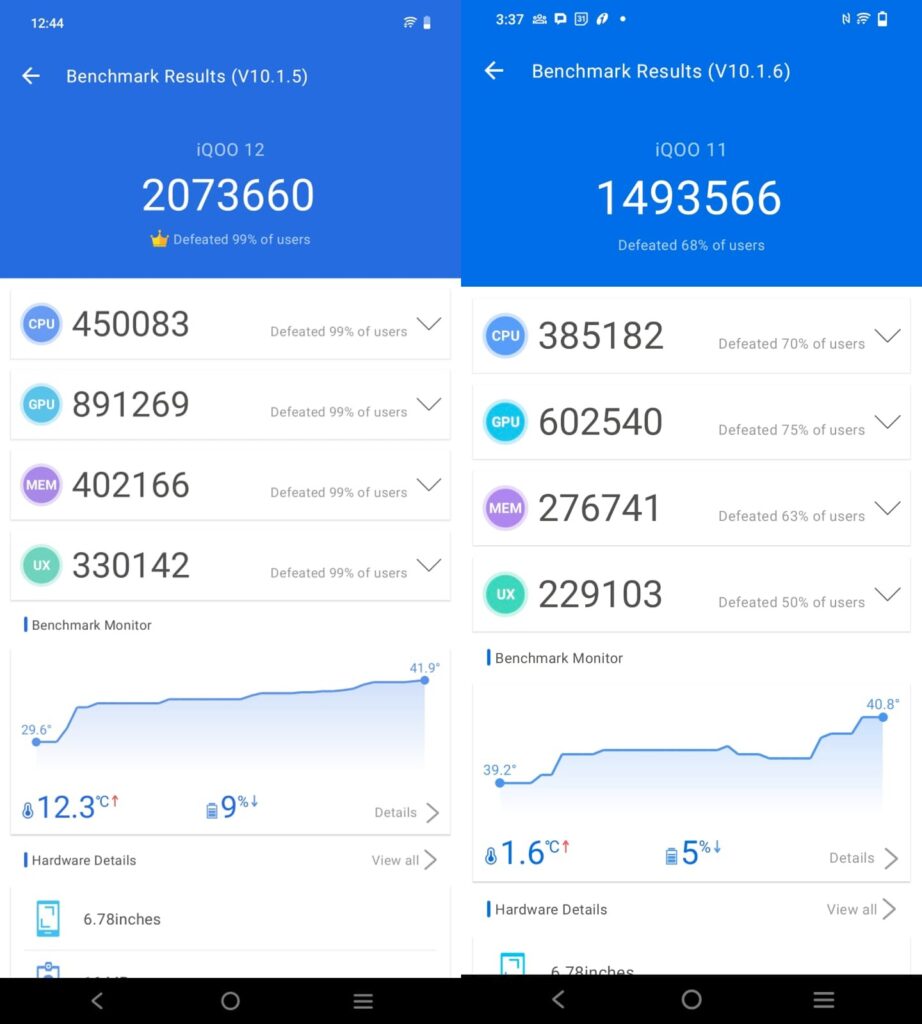
Powered by the latest Snapdragon 8 Gen 3 SoC, the iQOO 12 is the first of its kind. The SoC promises big performance and efficiency improvement over its predecessor. We set out to validate this assertion by pitting the iQOO 12 with its predecessor iQOO 11 (review), which is equipped with the Snapdragon 8 Gen 2 SoC. Our testing regimen encompassed benchmark apps, throttle tests, and gaming scenarios. Before we get to the results, let’s check out the iQOO 12 and iQOO 11 key specifications.
| iQOO 12 | iQOO 11 |
| 4nm octa-core Snapdragon 8 Gen 3 with one Cortex X3 super core clocked at 3.3GHz, three performance Cortex A720 cores clocked at 3.2GHz, two Cortex A720 cores clocked at 3GHz, and two Cortex A520 cores spinning at 2.8GHz. | 4nm octa-core Snapdragon 8 Gen one with Cortex X3 super core clocked at 3.19GHz, along with two performance Cortex A715 cores and two Cortex A710 cores, both spinning at 2.8GHz, and three Cotex A510 cores clocked at 2.0GHz. |
| Adreno 750 GPU | Adreno 740 GPU |
| up to 16GB RAM | up to 16GB RAM |
Table of Contents
Geekbench

The iQOO 12 Geekbench scores stand at 2,223 in the single-core test and 6,799 in the multi-core test, roughly 17 percent better than its predecessor, the iQOO 11. The latter achieved 2,036 in the single-core test and 5,502 in the multi-core test. This should give the latest iQOO flagship a competitive edge, allowing it to perform tasks at a relatively faster speed.
AnTuTu

The iQOO 12 AnTuTu score is the highest ever for a smartphone yet. The handset returned a whopping score of 20,73,660 on the benchmark platform. In comparison, the iQOO 11 achieved 14,93,566. It seems to be falling behind the iQOO 12 in all departments, including CPU, GPU, MEM, and UX, by some margin.
CPU Throttle

The iQOO 12 manages to outperform iQOO 11 in the CPU Throttle test as well, albeit marginally. The latter performed at 78 percent of its peak performance while running 50 threads for 30 minutes during the test. The iQOO 12, in contrast, showed more resilience, experiencing only a 20 percent throttling of its peak performance. This shouldn’t bring much difference in the real world and both smartphones should be capable of handling intense load for prolonged time.
Gaming


Gaming-wise, both games are capable of handling graphically-intensive activities such as gaming. I played BGMI on both devices with their maximum graphics and frame rate settings, Ultra HD and Ultra respectively. The devices flawlessly rendered graphics, exhibiting no stutter or lags, even when pushing the game to its limit.
Given the higher benchmarking scores, the iQOO 12 naturally has an edge. However, the difference might not be visible to the naked eye. It becomes noticeable only when you run the game on these devices side by side. That said, the graphics looked much smoother on the iQOO 12 compared to its counterpart.
Be that as it may, neither the iQOO 11 nor the iQOO 12 did not exhibit as much heating issue while gaming as they did during the benchmark tests. The cooling management system on both devices effectively maintained their optimal thermal conditions. The iQOO 12 thermals were slightly cooler than the iQOO 11, albeit by the slimmest of margins.
Verdict
The iQOO 12, powered by the Snapdragon 8 Gen 3, demonstrates significant performance gains over its predecessor, both on Geekbench and AnTuTu. Its CPU Throttle test result isn’t all that different from the Snapdragon 8 Gen 2-driven iQOO 11. However, when it comes to real-world performance, especially in gaming, the iQOO 12 exhibits superior graphics and a minimal spike in temperature. This makes the smartphone a compelling choice for users seeking top-notch performance in a flagship smartphone, at least for the time being.

![[Exclusive] iQOO is evaluating launch of gaming tablet in India Thumbnail](https://www.91-cdn.com/hub/wp-content/uploads/2024/04/Vivo-Pad-3-Pro-as-iQOO-Pad-2.png?tr=h-110,q-100,pr-true)










